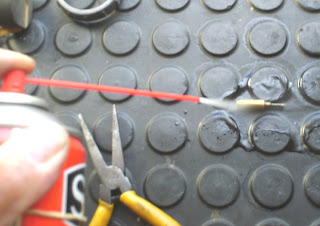Re-installing the battery or accumulator.
Ingredients needed for this recipe
Phillips screwdriver tip # 2 or stretch marks.
A-die rache 10mm.
A battery 12N14-3 A, preferably Yuasa brand is the original "NOS" or the brand that you prefer.
Step 1.
Our first mission will be prepared prior battery, remember to follow exactly the instructions on how to fill it with the electrolyte (dilute sulfuric acid solution) and as it should apply the initial load to it, in photo # 1.1 shows the original battery that uses
Note: I remind again should read and follow the instructions of how to prepare priori battery installed, this will extend the life of it and we save a lot of headaches, wasted time and money.
Photo # 1.1- Battery 12N14-3 Yuasa A list to be mounted.
Each battery usually comes equipped with a set of two 10mm bolts with their nuts, see photo # 1.2.
Photo # 1.2. Nuts with bolts or screws.
And where is the battery?, It's easy just below the seat, in what I call the battery cage, the Americans call it " Battery cage, Battery Box etc ... remember well the positive identification, usually the right and comes with a protective rubber hood, see picture # 1.3.
Photo # 1.3.-The battery cage indicated the positive wire into the red circle.
Tweaking the aim of which is attached the battery, see picture # 1.4.
Photo # 1.4-Squaring the battery well, seconds before lowering your resting place.
Step 2.
Aja, Here I wanted to go, please do not forget to place the vent pipe of the electrolyte, it comes in the box usually each battery, that although it seems foolish exaggeration or annoyance, it is extremely important because this small tube is evacuated the excesses of corrosive electrolyte, especially when, for example, there is an acute angle on the motorcycle or a problem occurs other occasioned by the overflow of it, I have seen many bikes with batteries without the consequent relief mounted with dripping paint on the frame, all destroyed, peeled, food, " eschoretada (stripped to my English friends), remember this liquid is highly corrosive and eats up the clothes, if they drop on the skin, wash immediately with soap and water, see picture # 2.1.
Photo # 2.1.-installing the vent pipe of the electrolyte solution, very important to make sure that is not blocked in any room and pointed at the ground.
Well, here is the battery on his throne of government, ready to manage all the energy resources of the bike, see photo # 2.2.
Photo # 2.2.-The battery in place inside the red circle is the Positive pole (+), eye peeled here.
Step 3.
will only tighten their terminals, each terminal is supplied with a nut that is placed just below it, a sure way to serve the bolt or nut 10mm secure the cable to the battery terminal, see picture # 3.1.
Photo # 3.1.-inserting the nut below the negative side, do it the same way with the positive.
then submit the screw above the terminal, it must grab the tip of the cable between the head and the clamp bolt with nut below, it is sometimes a bit annoying and delay the screw tip pinch grip or a nut to begin to tighten, so we always prefer to use a screwdriver (the screws that are not smooth) until I feel I get the screw and then tightened TUEC a rache see photos # 3.2, 3.3, 3.4 and 3.5.
Photo # 3.2.-placing the screw or bolt with the cable through already inserted.
Photo # 3.3.-initially use the screwdriver until you feel the screw thread the nut.
Foto3.4.-Tight final screw holding the negative lead to terminal, using a 10mm with a die rache, fit well, but neither will Goliaths pass.
Photo # 3.5.-Do the same with the cable terminal and the positive pole, first try to catch the nut with the use of screwdriver, until you feel you hold the thread.
Photo # 3.6.-Secure and tighten everything with the help of a rache , plus a 10mm since lLiz Taylor) as properly assembled battery Nippon Professional Soichiro Honda,,).
Note: As a suggestion, I can recommend permeate every terminal with a bit of a heavy oil or grease on them, this will prevent sulfation or oxidation of the same and also the cables, I think it is bad idea.
Again has been a delight to be able to share with you all this part of the restoration, as just seen, this part was a simple task to do, and more demanding challenges will come, I promise you, see you soon, bye .

































